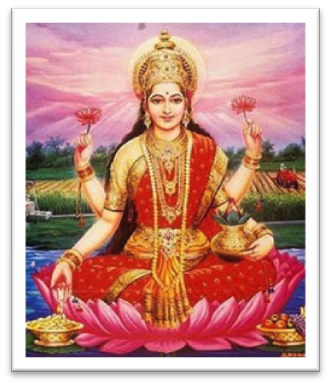
(© 2014. All original material in this Project is under copyright protection and is the intellectual property of the author.)

Photo courtesy of http://www.egreenway.com/yoga/tantra.htm
The Hindu goddess Lakshmi Devi, as worshipped today, arose from the bounteous splendor, majesty and wealth of ancient India. Devi is the word in Sanskrit for goddess. It derives from the root word div, which means to shine, to sparkle, to play, and all of those words evoke Lakshmi herself. The devis are luminous beings, and when one invokes a devi, one is bringing into sacred space a spirit that is divine luminosity. When that luminosity is called into being in the form of Lakshmi, one is calling forth a divine source of abundance, of wealth, of harmony, beauty, delight, and spiritual liberation.
In the earliest incarnations of Lakshmi, she is the Primordial Lotus Goddess. Before songs of praise came to be written down, Lakshmi was present in ancient Indian visual art. She was the lotus blossom; divinely feminine, graceful, lovely. She is seen seated on a lotus, her hands bearing blossoming lotuses, and tender shafts of burgeoning grain. She is the life force, fertility, and glorious abundance. She is known as Kamala, Ambuja, Padma, and Padmini. All of these names mean "lotus." She is seen as the divine mother, but she is also recognized as an aspect of inner divinity, residing in all mankind.
The divine personalities of Lakshmi are expressed differently in Vedic, Puranic, and Tantric texts of Sanskrit sacred literature.
Also recognized in the Vedic tradition is the personification of Lakshmi's opposite, known by the names of Nirrti, Alaksmi, and Papi-laksmi. This inauspicious presence brings evil, misfortune, misery, disease and death. Lakshmi and her dark opposite are never to be found in the same space; they are exact opposites; two sides of one coin. The Vedic Lakshmi is also fickle, restless, and wavering. Vedic invocations beseech her not only to arrive, but to stay. Thus one way of seeing Lakshmi is to recognize that she is part of a continuous movement of energy, an evocation of the fluid qualities of the goddess. To receive her blessings, one must step into her effervescent energy field; to succumb to laziness, apathy, hoarding, etc., will align one with the stagnant energy of her opposite, Alaksmi.
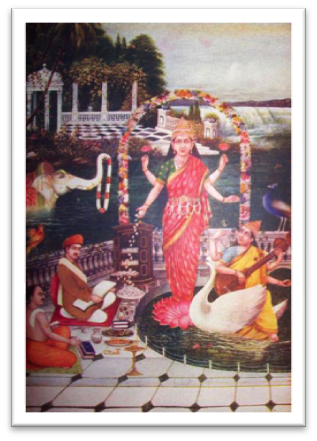
Photo courtesy of Wikipedia
Most lovely goddess Padmini
With lovely face
And lovely lotus-petal eyes,
O you who cherish the lotus,
O you who cherish the world,
O goddess whose heart pervades the universe,
To your lotus feet I bow.
- Hymn to Laksmi (Laksmi Suktam)
She is most closely affiliated with Vishnu. She is said to have emerged from the Milk Ocean when the gods churned it, and she immediately became Vishnu's consort. As such, she accompanies him whenever he intercedes to uphold creation; together they grant energy of bounteous life here on earth. Just as she dwells with Vishnu in heavenly form, so her domain is equally the earthly realm and the netherworlds. Indra, Vishnu and Bali all require Lakshmi to animate his realm. It seems to me that in the Purana writings, Lakshmi always maintains a traditional feminine role, unlike her divine form in the Vedic tradition, where she was not especially associated with a male energy or divine avatar.
Puranic Lakshmi is the embodiment of the "Four Wealths": dharma, artha, kama, and moksa. Kama is the wealth of pleasure, sensuality, and sexuality. Lakshmi can be compared to Aphrodite. Artha is material wealth, and prosperity consciousness. Images of Lakshmi often show her pouring forth unending streams of gold coins. Dharma is Wealth of Virtue and harmonious relationships. Moksa is the wealth of spiritual liberation.
There are eight forms of Goddess Lakshmi known as Ashta Lakshmi, who preside over eight forms of wealth, mainly prosperity, power, health, progeny, cattle, grains, gold and strength. The Ashta Lakshmi are all depicted seated on a lotus.
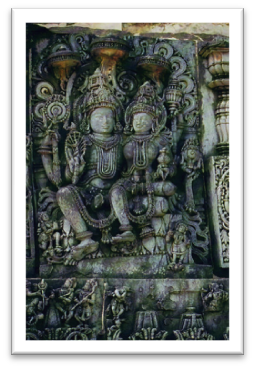
Vishnu & Lakshmi (courtesy of Wikipedia)
You are the supreme mother of all,
And every woman is an embodiment of you.
So do you express yourself in the forms
Of dharma, artha, kama, and moska.
- Song for the Glorious Lotus Goddess (Sri Kamala Stotram)
Here she is still the lovely lady of the lotus, but she is also a fierce goddess. Here, she expresses herself as Kundalini – the divine power that exists within our own bodies. Lakshmi may be called upon for her powers of destruction, to tear down what no longer works. The Tantric perspective gives us a holistic view; darkness and turbulence can be very powerful triggers for change, and Lakshmi is the catalyst. Working with chakras is a powerful tool for accessing Lakshmi's power of transformation.
In Tantric tradition, Lakshmi is often identified as Kamala. Kamala's role is to preside over the attainment of worldly comfort and prosperity, because it is necessary to come to terms with the world before one can leave it behind. Kamala represents the turning point, the point of departure from worldly consciousness and the path of spiritual transformation.
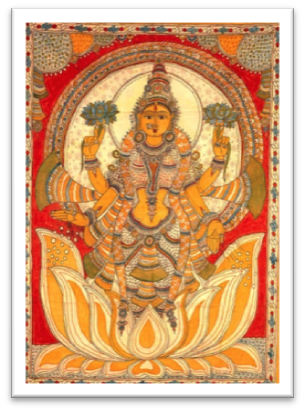
O Mother,
Deeply embedded
Is my fear, my insecurity.
Have mercy, O Mother, on my wretched state.
Uproot it
From the joy that arises
From your sweet and compassionate glance.
O Mother of the Universe,
Infuse your children with fearlessness!
Plant in us the seed of auspiciousness
As we make our way in this world.
- The Secret Heart of Laksmi (Sri Mahalaksmi Hrdayam)
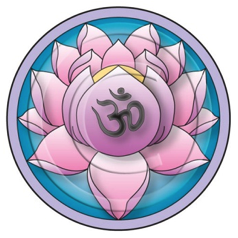 Always, Lakshmi retains her core essence as the divine feminine; all of her forms are strictly female. She is the embodiment of Mother Earth; rivers are recognized as a form of her. She manifests as Padma, the lotus; she manifests as the sacred basil plant, Tulasi. And every woman is an embodiment of Lakshmi. Every woman is said to be a form of the goddess and thus an extension of the goddess's power. Thus, mundane household tasks such as washing dishes, cooking, tending children, take on spiritual significance and can be seen as ritual. When seen as such, woman becomes empowered, and queen of her realm.
Always, Lakshmi retains her core essence as the divine feminine; all of her forms are strictly female. She is the embodiment of Mother Earth; rivers are recognized as a form of her. She manifests as Padma, the lotus; she manifests as the sacred basil plant, Tulasi. And every woman is an embodiment of Lakshmi. Every woman is said to be a form of the goddess and thus an extension of the goddess's power. Thus, mundane household tasks such as washing dishes, cooking, tending children, take on spiritual significance and can be seen as ritual. When seen as such, woman becomes empowered, and queen of her realm.
Om hrim shrim lakshmi namah svaha!
[Seed Syllable is SHRIM (pronounced with an 'ng' ending)].
Sacred to Lakshmi are cows, gold coins, precious gems, sprouts of grain, green plants, lotus, She is often shown with sprouts of grain amidst green plants, bestowing coins of prosperity, and flanked by elephants shown showering her with water, signifying her power. In some texts she is shown with an owl, signifying her 'vahana', or vehicle from the spirit world into the material. This is of interest to me because owl has always been my main totem.
Lakshmi puja is a Hindu ritual performed during Diwali, the festival of lights. Traditionally, people put small oil lamps outside their homes on Diwali and hope Lakshmi will come to bless them. It is believed that Lakshmi (wealth) goes only to those houses which are clean and where the people are hardworking. She does not visit the places which are unclean/dirty or where the people are lazy. The third day of the festival of Diwali is the most important day of Lakshmi-puja and is entirely devoted to petitioning Goddess Lakshmi for blessings of abundance and good favor. On this very day sun enters his second course and passes Libra which is represented by the balance or scale. Hence, this design of Libra is believed to have suggested the balancing of account books and their closing. Despite the fact that this day falls on an amavasya day it is regarded as the most auspicious.
For more information, see: http://en.wikipedia.org/wiki/Lakshmi_Puja
Phillips, Charles; Kerrigan, Michael; Gould, David. Myth & Mankind. The Eternal Cycle: Indian Myth. Duncan Baird Publishers, London. 2005
Trinetra Online: Goddess Lakshmi-Symbolism http://www.trinetra.org.uk/#/goddess-lakshmi-symbolism/4550285139